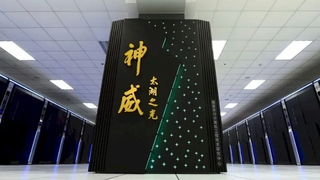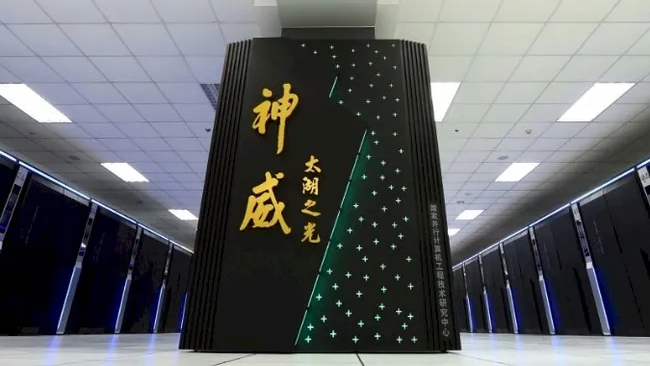beijingwalker
ELITE MEMBER

- Joined
- Nov 4, 2011
- Messages
- 65,191
- Reaction score
- -55
- Country
- Location
US guru says China’s supercomputer power may exceed all countries but flies under the radar because of sanctions
- Jack Dongarra, professor, Turing laureate and co-founder of TOP500 supercomputer list, says China still produces the most ultra-fast computers
- He speculates having the world’s No.1 computer may ‘cause the US to take actions against China that would further restrict technologies from flowing into China’

Turing Award laureate and University of Tennessee Professor Jack Dongarra spoke at a workshop on exascale high-performance computing software and algorithms in Beijing last month. Photo: Jack Dongarra
A US supercomputer guru says three next-generation supercomputers may already be up and running in China, a greater number than any other country, but that the world knows little about them because of US sanctions.
The Chinese exascale computers, like their United States counterpart at the Oak Ridge National Laboratory in Tennessee, are expected to perform at least one quintillion – or 1,000,000,000,000,000,000 – calculations per second and they may have a higher peak performance, said Turing Award laureate and University of Tennessee professor Jack Dongarra.
Dongarra said Chinese scientists seemed to be “quite proud of the machines they have”, even though those machines have never appeared on the TOP500 list – the most influential ranking of the 500 fastest supercomputer systems in the world.
Dongarra, who attended a workshop on exascale high-performance computing software and algorithms in Beijing last month, made the comments in an interview with the South China Morning Post after his return to the US.
“It’s a well known situation that China has these computers, and they have been operating for a while. They have not run the benchmarks, but [the community has] a general idea of their architectures and capabilities based on research papers published to describe the science coming out of those machines,” he said.
The Frontier system built and hosted by the US Department of Energy’s Oak Ridge National Lab was at the top of the most recent TOP500 list released in June.
Based on the HPL score, a technical way of measuring the performance of supercomputers, it had a rate of execution nearly triple that of the second placed machine, the Fugaku supercomputer based in Kobe, Japan. This made it the only exascale system on the chart.
In 2018, Chinese state media reported that the country had completed three prototype exascale systems: the Sunway OceanLight developed by the National Supercomputing Centre in Wuxi, the Tianhe-3 by the National Supercomputing Center of Tianjin, and one by the Chinese company Sugon for the National Supercomputing Center in Shenzhen.
Dongarra said that absence of top Chinese computers from official rankings was likely to be a result of geopolitical tensions in recent years.
Previously, Chinese institutions and companies were enthusiastic about submitting details of their machines and benchmark runs to the TOP500 list.
“Being a top 10 on the list was a big deal and seen as a trophy a country had to boast about,” said Dongarra, who is a co-founder of the list.
In 2013, the Tianhe-2 system developed by China’s National University of Defence Technology surpassed Oak Ridge’s Titan to become the most powerful supercomputer, challenging US dominance in the area.
Two years later, the US government banned Intel from selling chips to help upgrade Tianhe-2. In 2021, seven supercomputer centres involved in developing China’s next-generation supercomputers were blacklisted by the US.
Dongarra said that although more supercomputer builders in China had stopped reporting their machines in the past two years, some continued to put their computers forward for ranking.
“Maybe having the No.1 computer would make news and put China under the spotlight. It can cause the US to take actions against China that would further restrict technologies from flowing into China.”
As the number of supercomputers in China being reported kept shrinking, it lost the No 1 position in terms of the total number of machines among the Top500, he said.
“However, China is still the country which produces the most supercomputers. With domestic and Western-designed chips, supercomputers assembled in China are sold all over the world, including the US.”
Dongarra, who met officials from the Chinese Academy of Sciences to discuss potential communication, interaction and partnership during his trip to Beijing, said international cooperation was important.
A significant part of today’s science was driven by computer simulation, and the countries with the biggest computers could do the best science, he said. However, building a new supercomputer system was labour-intensive and required a lot of funding.
“If the global community can better leverage resources, we’ll be able to avoid duplication in our work and collaborate more effectively.”

Exclusive: US guru says China’s supercomputer power may exceed all countries
Jack Dongarra, professor, Turing laureate and co-founder of TOP500 list, says China still produces the most supercomputers.


